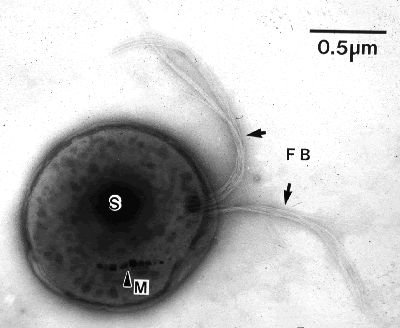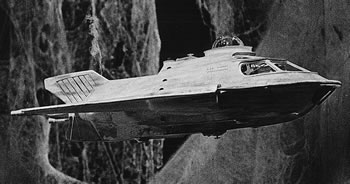Science Fiction
Dictionary
A B C D E F G H I J K L M N O P Q R S T U V W X Y Z
Bacteria Guided Through Bloodstream W/Magnetic Fields

Small bacteria - Strain MC-1 - can be guided through the bloodstream of a living creature using magnetic fields. Sylvain Martel's team at the École Polytechnique de Montréal thinks that these bacteria can be loaded with drugs or some other payload and then be made to swim to a specific destination in the body.
Take a look at this video, showing bacteria being guided by magnetic fields:
(Bacteria guided by magnetic fields)
Regular Technovelgy readers should recall experimental work done to try to duplicate the flagellar 'propeller' of bacteria, to create a tiny machine able to move through the bloodstream like the shrink ray-reduced Proteus, the fictional craft from movie Fantastic Voyage. See the work done by Dr. Friend in Australia in Microrobot To Swim Like Bacteria With Flagellar Propeller and the research of Dr. Shoham of Israel in Propulsion System For 'Fantastic Voyage' Robot.
However, Dr. Martel thinks that the original organism might be better than a biomimetic robot:
"Instead of trying to build a nanomachine it makes more sense to spend effort trying to control what nature provides," says Martel. He and his team are focusing on a bacterium dubbed MC-1 – a microbial speed demon that swims 10 times faster than most species and can travel at top speeds of 200 micrometres per second using its twirling flagella.Apart from speed, the bacterium has another property that makes it a perfect candidate for the role: each cell contains a chain of magnetic nanoparticles, allowing the bacteria to sense and swim along magnetic fields.

(MC-1 cell. FB=flagellar bundles; M=magnetsosomes [Frankel et al., 1997])
Compare with Proteus, below
Here is the abstract from the research study:
Although nanorobots may play critical roles for many applications in the human body, such as targeting tumoral lesions for therapeutic purposes, miniaturization of the power source with an effective onboard controllable propulsion and steering system have prevented the implementation of such mobile robots. Here, we show that the flagellated nanomotors combined with the nanometer-sized magnetosomes of a single magnetotactic bacterium can be used as an effective integrated propulsion and steering system for devices, such as nanorobots, designed for targeting locations only accessible through the smallest capillaries in humans while being visible for tracking and monitoring purposes using modern medical imaging modalities such as magnetic resonance imaging. Through directional and magnetic field intensities, the displacement speeds, directions, and behaviors of swarms of these bacterial actuators can be controlled from an external computer.
(From Flagellated Magnetotactic Bacteria as Controlled MRI-trackable Propulsion and Steering Systems for Medical Nanorobots Operating in the Human Microvasculature)
The initial trials were done in rats; the MC-1 bacteria naturally die after about 40 minutes in the blood and are then cleaned up by the immune system.

(Proteus from Fantastic Voyage)
Via New Scientist.
Scroll down for more stories in the same category. (Story submitted 5/4/2009)
Follow this kind of news @Technovelgy.| Email | RSS | Blog It | Stumble | del.icio.us | Digg | Reddit |
Would
you like to contribute a story tip?
It's easy:
Get the URL of the story, and the related sf author, and add
it here.
Comment/Join discussion ( 1 )
Related News Stories - (" Medical ")
BrainBridge Concept Transplant Of Human Head Proposed
'Briquet’s head seemed to think that to find and attach a new body to her head was as easy as to fit and sew a new dress.' - Alexander Belaev (1925)
Natural Gait With Prosthetic Connected To Nervous System
'The leg was to function, in a way, as a servo-mechanism operated by Larry’s brain...' - Charles Recour, 1949.
Brain Implant Is Able To Capture Your Inner Dialogue
'So you see, you can hide nothing from me.'
'Pregnancy Humanoids' From China Replace Moms
'A great many of these synthetic babies were made...' - David H. Keller, 1928.
Technovelgy (that's tech-novel-gee!) is devoted to the creative science inventions and ideas of sf authors. Look for the Invention Category that interests you, the Glossary, the Invention Timeline, or see what's New.
Science Fiction
Timeline
1600-1899
1900-1939
1940's 1950's
1960's 1970's
1980's 1990's
2000's 2010's
Current News
The Zapata Air Scooter Would Be Great In A Science Fiction Story
'Betty's slapdash style.'
Thermostabilized Wet Meat Product (NASA Prototype)
There are no orbiting Michelin stars. Yet.
Could Crystal Batteries Generate Power For Centuries?
'Power could be compressed thus into an inch-square cube of what looked like blue-white ice'
India Ponders Always-On Smartphone Location Tracking
'It is necessary... for your own protection.'
Amazon Will Send You Heinlein's Knockdown Cabin
'It's so light that you can set it up in five minutes by yourself...'
Is It Time To Forbid Human Driving?
'Heavy penalties... were to be applied to any one found driving manually-controlled machines.'
Replace The Smartphone With A Connected Edge Node For AI Inference
'Buy a Little Dingbat... electropen, wrist watch, pocketphone, pocket radio, billfold ... all in one.'
Artificial Skin For Robots Is Coming Right Along
'... an elastic, tinted material that had all the feel and appearance of human flesh and epidermis.'
Robot Guard Dog On Duty
I might also be thinking of K-9 from Doctor Who.
Wearable Artificial Fabric Muscles
'It is remarkable that the long leverages of their machines are in most cases actuated by a sort of sham musculature...'
BrainBridge Concept Transplant Of Human Head Proposed
'Briquet’s head seemed to think that to find and attach a new body to her head was as easy as to fit and sew a new dress.'
Google's Nano Banana Pro Presents Handwritten Math Solutions
'...copy was turned out in a charming and entirely feminine handwriting.'
Edible Meat-Like Fungus Like Barbara Hambly's Slunch?
'It was almost unheard of for slunch to spread that fast...'
Sunday Robotics 'Memo' Bot Has Unique Training Glove
'He then started hand movements of definite pattern...'
Woman Marries Computer, Vonnegut's Dream Comes True
'Men are made of protoplasm... Lasts forever.'
Natural Gait With Prosthetic Connected To Nervous System
'The leg was to function, in a way, as a servo-mechanism operated by Larry’s brain...'
